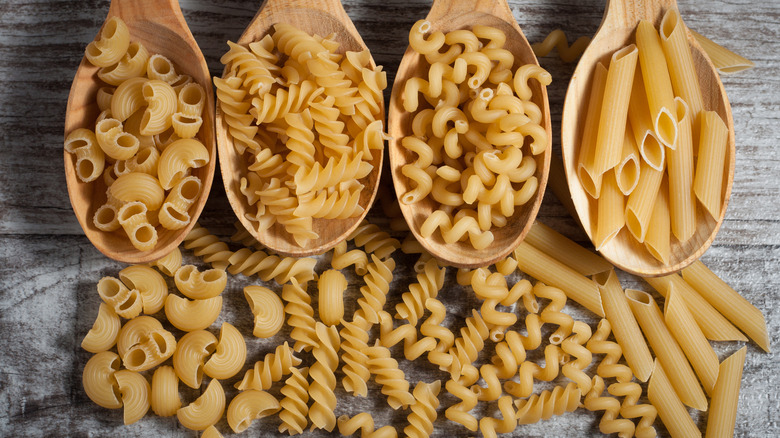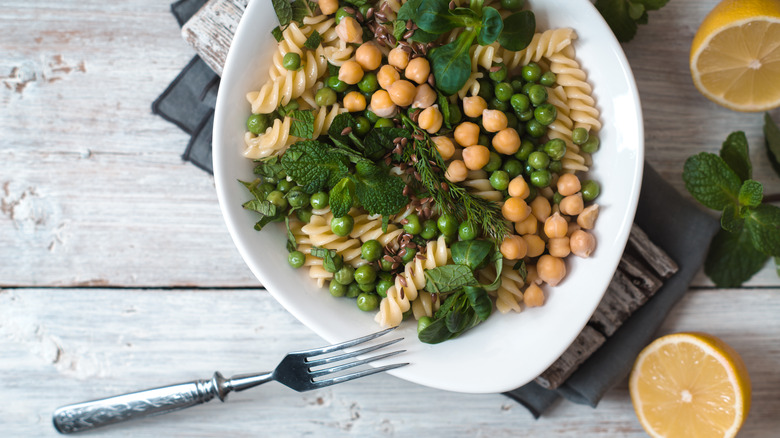Is Chickpea Pasta Really Better For You?
Food in the modern day seems to have evolved into a master magician: cauliflower can be turned into rice, oats into milk, squash into noodles, and so on. In today's world, it's as if you can turn anything into pasta, including lentils, black beans, and even chickpeas. Chickpea pasta has been on the market for some time, but you may be wondering — is it actually better for you than traditional pasta?
Chickpea pasta is made by grinding up chickpeas and combining it with either tapioca or pea protein (or some variation of all) for adequate binding, as per Healthline. Aside from being a good alternative to wheat-based pasta, chickpea pasta also has some different nutritional benefits. For starters, it has more protein and fiber than traditional pasta, along with many micro and macronutrients.
In a 2-ounce serving, for example, chickpea pasta is made up of approximately 32 grams of carbohydrates. But before you throw out any and all traces of pasta in your pantry, consider that the starches in chickpeas are actually complex carbohydrates (per Women's Health). Luckily, complex carbs contain more fiber and break down slower than simple carbs, which means they make you feel fuller sooner and for a longer period of time (via Healthline). Particularly, those with Type 2 diabetes have more to gain since they help better manage sugar spikes that occur naturally after meals. Complex carbs are also important in helping maintain a healthy weight and may be beneficial to overall cardiovascular health.
Additional benefits of eating chickpea pasta
Additionally, the high fiber content of chickpeas promotes digestive health by aiding in gut microbiome diversity and regulating bowel movements (via Healthline). Chickpea pasta's high protein content also helps build and repair muscle, according to HealthReporter.
Another perk to consuming legume-based pasta over traditional pasta is that it is a great alternative for people with sensitivities to gluten, reports Healthline. Although unlikely, WebMD states that it is possible to be allergic to the contents of chickpea pasta. Therefore, be sure to check the package for hidden allergens or cross-contamination warnings.
Methods for cooking chickpea pasta may vary by brand but are not all that different from cooking traditional pasta, notes Healthline. While you may pick up on a slightly more grainy texture with chickpea pasta than regular pasta, throwing in some vegetables and appropriate sauces can help balance out the taste. Ultimately, chickpea pasta does have some additional nutritious benefits not found in traditional pasta and, thus, it can be considered a healthier option, but as with all food recommendations, regardless of which pasta you choose, portion size is always the real key. So when you're prepping your next meal, see if you can substitute your usual noodles with this delicious legume alternative.
Chickpea pasta versus white and wheat pasta
When looking at the nutritional value of chickpea pasta versus other popular pastas, you'll find that you get nearly double the bang for your buck. In fact, a 2-ounce serving of dry chickpea pasta contains about twice the amount of protein than the same size serving of regular whole wheat pasta or white pasta, according to Healthline. In that same serving, you'll also find 30% of your recommended daily intake of iron. In comparison, whole wheat pasta offers only 11% of your daily recommended iron intake, and white pasta contains even less at 10% of one's daily recommended intake. Furthermore, Good Housekeeping reports that while a 2-ounce serving of Barilla Regular Rotini contains 2% of the recommended daily intake for potassium, the same serving of Barilla's Chickpea Rotini harbors 15% of the daily value (DV). Overall, chickpea pasta can be a tasty choice for those looking to manage their blood sugar levels, support their gut health, heart health, and more (via Healthline).
If you're excited by the prospect of giving chickpea pasta a try, experts at Good Housekeeping offer this tip for first-timers: stay hydrated. If you're low on fluids, uncomfortable bloating may set in as your body adjusts to the high levels of fiber in the flour.



